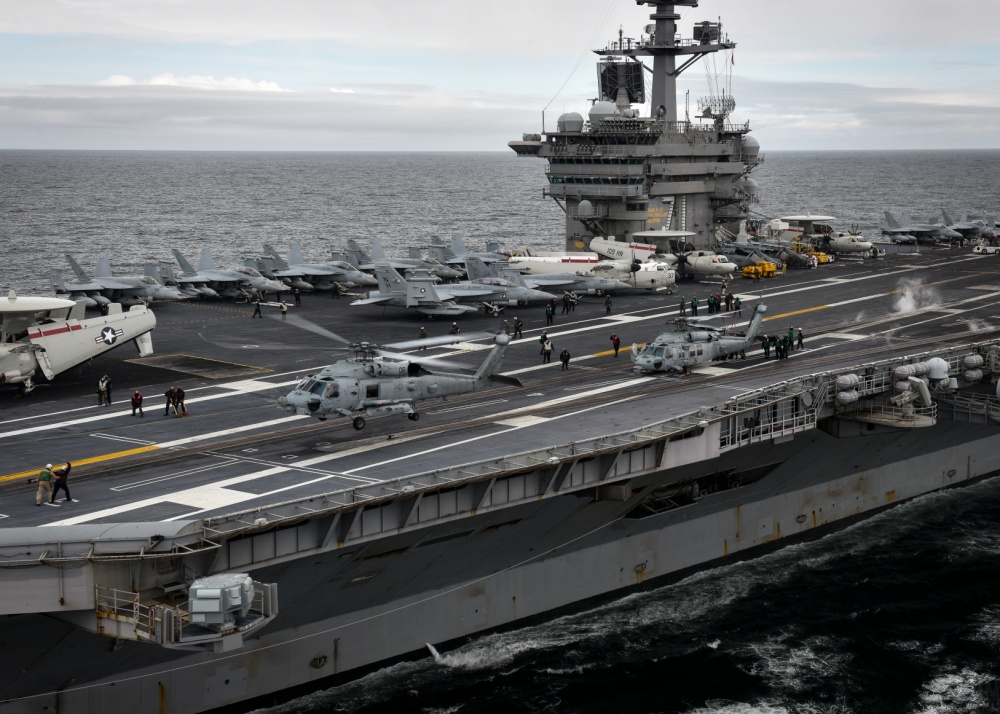
(Courtesy PO2 Anthony J Rivera / U.S. Navy)
This article has been updated to clarify that Northern Edge has traditionally taken place once every two years.
Thousands of troops and the latest in American military hardware will soon descend on Alaska for war games between branches of the armed forces. “Northern Edge” is a biennial, large-scale exercise held in May. And planners are looking ahead at the next decade of maneuvers in Alaska’s skies and waters.
Northern Edge 2021 will span from the Aleutians to Fairbanks to Juneau, in the air, and on the water in the Gulf of Alaska.
“We’re going to have 240 joint aircraft, so that’s aircraft from the Air Force, Navy, Marine Corps, Army,” says Capt. Kitsana Dounglomchan. He’s a U.S. Air Force spokesman. “I mean, you’re talking everything from fighter jets to tankers to helicopters, to B1-B Lancer bombers. And it’s really the entire suite, as far as aircraft assets that are coming up — and that’s from all of the services. From the Navy, we have six ships coming. And then we even have one oiler.”
This will be the first time that both an aircraft carrier strike group and an amphibious ready group — which is a joint force of the Navy and Marines — will be participating in Northern Edge. The exercises are designed to make sure military branches can work together and communicate effectively in a theater of war. Capt. Dounglomchan says that the war games planners are the only ones who will know what the goal of each training mission will be.
“The people that are operating on the aircraft and on the ships and on the ground, they don’t really know what’s going to be happening the exercise, and it’s going to be up to them to react to those situations, and to figure out the best way to execute the exercise,” Capt. Dounglomchan explains.
The U.S. Navy says that one of their goals for the massive, joint-forces military operation is to not get in the way of smaller vessels, or marine life.
“It’s easier for us to conduct the training we need to do if the other vessels aren’t in the vicinity — we’re not interfering with them, they’re not interfering with us. So we simply move to a location that is free and clear,” says U.S. Navy civilian environmental planner John Mosher.
It might seem counterintuitive that an aircraft carrier, hundreds of planes, and thousands of military personnel can be unobtrusive. But Mosher says that the training and activities are conducted in an area the Navy has assessed will have a minimum impact on Alaska’s fisheries and other marine life.
“It’s away from a lot of the habitat areas for species too, so that from the start kind of avoids a number of those potential conflicts,” he adds.
Mosher says that the Navy has permits to do a lot more training than they end up doing. So if they spot a whale, or if there are fishing boats in the area, they can shift things around without disrupting their game plan. If it’s a marine mammal that causes a shift in plans, the Navy reports the change to the federal agency tasked with protecting whales, dolphins, seals and the like. Mosher says that data is logged and can be used by regulators when reviewing future use applications for the Gulf of Alaska.
As for the humans out on the water — often fishermen — Mosher says the Navy doesn’t have the legal authority to direct civilian traffic. So they do their best to keep out of the way of the fishing fleet: “We share the marine waters with all the other users, so we will typically avoid areas that have other users in them. Just simply avoid, for our convenience.”
Mosher adds that most of the activities in the ocean will be taking place more than 100 miles from shore — in theory, far away from fishing areas. If vessels or other marine users have an AIS — Automatic Information System — that shows real-time shipping traffic, they’ll be able to see their warships.
“Additionally, we operate and monitor VHF Channel 16 radio communications,” Mosher adds. “Typically all the vessels that are out at sea are on that channel. And then we do go through the process of simply notifying in advance of the activity so there’s awareness of where we expect to be.”
Mosher says the Navy has been in touch with coastal communities, tribal governments and fishing groups about future plans.
That’s because it’s applying for permits for training exercises through 2029. To do that, it’s had to update its Environmental Impact Statement for its maneuvers in the Gulf of Alaska.
Environmental organizations and fishing groups have expressed concern about military presence around Alaska’s fishing grounds. While the exercises are well outside state waters, some worry about the possible ocean effects on fish and marine mammals, especially since the exercises often take place right as Alaska’s salmon begin returning to spawn.
Mosher explains that the Navy times its activities carefully. A few months later and there would be more marine mammals around, which are specifically protected by federal law: “So there would be a greater potential to protect marine mammals, even though we’d be avoiding a specific fishing season. So it’s kind of a trade-off of different potential species, different effects to the environment.”
Ultimately, Mosher notes that the Navy invests millions of dollars in oceans research to try and make sure they can balance directives: prepare the military, and also protect the marine environment.
“It’s something that keeps a lot of us busy. It’s something we’re working on every single day,” Mosher says.
The next public comment period for the Gulf of Alaska activities won’t be until next year. That’s after the Navy releases the final environmental statement outlining its future plans in Alaska’s waters.
Get in touch with KSTK at news@kstk.org or (907) 874-2345.











